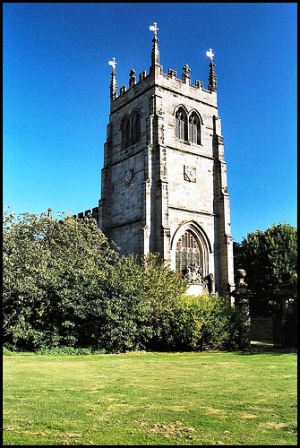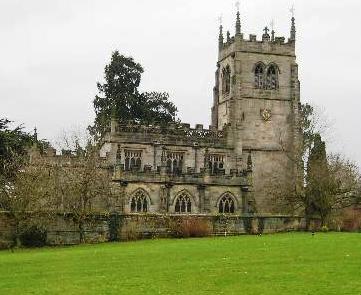ROBERT SHIRLEY (1629 - 1656)
“To have done the best thing in the worst times. And hoped in them in most callamitious.”
One of the most outstanding loyal sons of the English church during the Interregnum must have been Robert Shirley who left for posterity the beautiful gothic church at Staunton Harold, Derbyshire. By building it in this style it was bearing witness to the catholicity and the continuity of the English Church with its past. The inscription over the west doors sums it all up: “To have done the best thing in the worst times. And hoped in them in most callamitious.”
He was a descendant of the ancient family seated at Eatington. His father and grandparents were recusants, but he was brought up within the Church of England by his mother. When his elder brother, Charles, died in 1645 he inherited the baronetcy.
 Following the execution of Charles I he worked in close contact with those aiming for the restoration of monarch and church. Prior to the king’s execution he first clashed with the government in 1648 when he confronted soldiers at the parliamentary garrison at Ashby-de-la-Zouch. Two years later his anti-government agenda led to his first imprisonment in the Tower the sequestration of his estates, though he was soon released and the sequestration lifted. In the fifties he was very much at the centre of the plans to restore both monarchy and church. For such involvement he was again imprisoned in the Tower. While there he was appointed the royalists' financial agent, having already given substantial sums for the king's service.
Following the execution of Charles I he worked in close contact with those aiming for the restoration of monarch and church. Prior to the king’s execution he first clashed with the government in 1648 when he confronted soldiers at the parliamentary garrison at Ashby-de-la-Zouch. Two years later his anti-government agenda led to his first imprisonment in the Tower the sequestration of his estates, though he was soon released and the sequestration lifted. In the fifties he was very much at the centre of the plans to restore both monarchy and church. For such involvement he was again imprisoned in the Tower. While there he was appointed the royalists' financial agent, having already given substantial sums for the king's service.
 He worked tirelessly for the restoration of episcopacy. Yet he was critical of the low-profile attitude that most of the bishops had adopted. Hence most of the ground work for this restoration fell on faithful priests, with Henry Hammond perhaps the most hard-working priest for the restoration of Church but helped by Thorndike, Taylor, Pierce, Pearson and Sheldon who was chaplain to the Shirley’s household and of course Shirley himself. It was Shirley’s involvement in this cause that led to his last arrest in 1656. From his prison he drew up proposals for royalist reorganization on the basis of complete identification of the royal cause with the Church of England, urging that ‘whosoever in these times of persecution professes himself a son of the Church will also by the same principles be a loyal subject’. With clergy acting as agents, bishops would be required to resume their episcopal responsibilities, and the laity must refuse any ministry by ministers lacking episcopal ordination. Weekly communions were advocated, as were alms to provide for the support of the clergy, but the proposals failed to bear fruit.
He worked tirelessly for the restoration of episcopacy. Yet he was critical of the low-profile attitude that most of the bishops had adopted. Hence most of the ground work for this restoration fell on faithful priests, with Henry Hammond perhaps the most hard-working priest for the restoration of Church but helped by Thorndike, Taylor, Pierce, Pearson and Sheldon who was chaplain to the Shirley’s household and of course Shirley himself. It was Shirley’s involvement in this cause that led to his last arrest in 1656. From his prison he drew up proposals for royalist reorganization on the basis of complete identification of the royal cause with the Church of England, urging that ‘whosoever in these times of persecution professes himself a son of the Church will also by the same principles be a loyal subject’. With clergy acting as agents, bishops would be required to resume their episcopal responsibilities, and the laity must refuse any ministry by ministers lacking episcopal ordination. Weekly communions were advocated, as were alms to provide for the support of the clergy, but the proposals failed to bear fruit.
 Shirley died in the tower probably from smallpox. Yet his work was rewarded as it was this close-knit group of royalist-faithful priests and laymen that prepared the way for the Religious Settlement of 1662.
Shirley died in the tower probably from smallpox. Yet his work was rewarded as it was this close-knit group of royalist-faithful priests and laymen that prepared the way for the Religious Settlement of 1662.
 He lives and what he stood for in that most beautiful Gothic Church at Staunton Harold. It was a defiant act against Cromwell’s government. Although Shirley died before the whole church was completed, he left explicit instructions in his will for its completion. When finished it truly manifested Catholic worship with its altar on a raised platform at the east end the focal point from the west-end. Elaborately styled in oak it is the only piece of furniture in this long sanctuary separated from the nave by a screen. On the eastern wall on either side of the altar, are the Creed, the Lord’s Prayer, and the Ten Commandments. One of the aesthetic features of the church, crafted by William Smith, was its magnificent carved woodwork, manifested in the sanctuary panelling featuring “paired blank arches with diamond rustication and pendants between pilasters with strapworks and cherub’s heads”, “cornice with leaf volutes, egg- and-dart, leaf trailling, shields and rostettas.” It was also seen in the two-tiered pulpit, placed to one side of the screen in the nave so as not to distract from the altar. A further sign that it was built for English Catholic worship was reflected, as Pevsner expressed it, in the harking “back to the early fourteenth century with cusped intersected and Y-tracery” and the motifs of fleur-de-lis in the lower windows. Another feature was “clouding” the ceilings. The theme for the nave was creation, suggesting that out of chaos God brings life and order (a favourite theme of Andrewes), while the sanctuary ceiling over the altar features “a circle of winged heads represented alternately as singing Halleluiah and Sanctus, Sanctus, Sanctus.” This reminded worshippers that as they gather around the altar their prayers and offerings were mingled with those of the choir of heaven, and so the whole Catholic Church is gathered in the Eucharistic offering. Outside, “the tower has a four-light Perpendicular west window, Perpendicular window paired bell-openings with Y- tracery, battlements and pinnacles,” while the “intermediate pinnacles” are “in the shape of fleur-de-lis.”
He lives and what he stood for in that most beautiful Gothic Church at Staunton Harold. It was a defiant act against Cromwell’s government. Although Shirley died before the whole church was completed, he left explicit instructions in his will for its completion. When finished it truly manifested Catholic worship with its altar on a raised platform at the east end the focal point from the west-end. Elaborately styled in oak it is the only piece of furniture in this long sanctuary separated from the nave by a screen. On the eastern wall on either side of the altar, are the Creed, the Lord’s Prayer, and the Ten Commandments. One of the aesthetic features of the church, crafted by William Smith, was its magnificent carved woodwork, manifested in the sanctuary panelling featuring “paired blank arches with diamond rustication and pendants between pilasters with strapworks and cherub’s heads”, “cornice with leaf volutes, egg- and-dart, leaf trailling, shields and rostettas.” It was also seen in the two-tiered pulpit, placed to one side of the screen in the nave so as not to distract from the altar. A further sign that it was built for English Catholic worship was reflected, as Pevsner expressed it, in the harking “back to the early fourteenth century with cusped intersected and Y-tracery” and the motifs of fleur-de-lis in the lower windows. Another feature was “clouding” the ceilings. The theme for the nave was creation, suggesting that out of chaos God brings life and order (a favourite theme of Andrewes), while the sanctuary ceiling over the altar features “a circle of winged heads represented alternately as singing Halleluiah and Sanctus, Sanctus, Sanctus.” This reminded worshippers that as they gather around the altar their prayers and offerings were mingled with those of the choir of heaven, and so the whole Catholic Church is gathered in the Eucharistic offering. Outside, “the tower has a four-light Perpendicular west window, Perpendicular window paired bell-openings with Y- tracery, battlements and pinnacles,” while the “intermediate pinnacles” are “in the shape of fleur-de-lis.”
 During those turbulent years of the interregnum Shirley had sheltered, supported and employed some of the deprived clergy, amongst them were: Robert Mapletoft, Gilbert Sheldon, Henry Hammond, and Peter Gunning. He clearly showed too how laity and clergy can work close together in a cause with both sides respecting the other. He is indeed a worthy son of the Caroline Church who upheld all that was beautiful and catholic in worship and doctrine.
During those turbulent years of the interregnum Shirley had sheltered, supported and employed some of the deprived clergy, amongst them were: Robert Mapletoft, Gilbert Sheldon, Henry Hammond, and Peter Gunning. He clearly showed too how laity and clergy can work close together in a cause with both sides respecting the other. He is indeed a worthy son of the Caroline Church who upheld all that was beautiful and catholic in worship and doctrine.
Marianne Dorman

